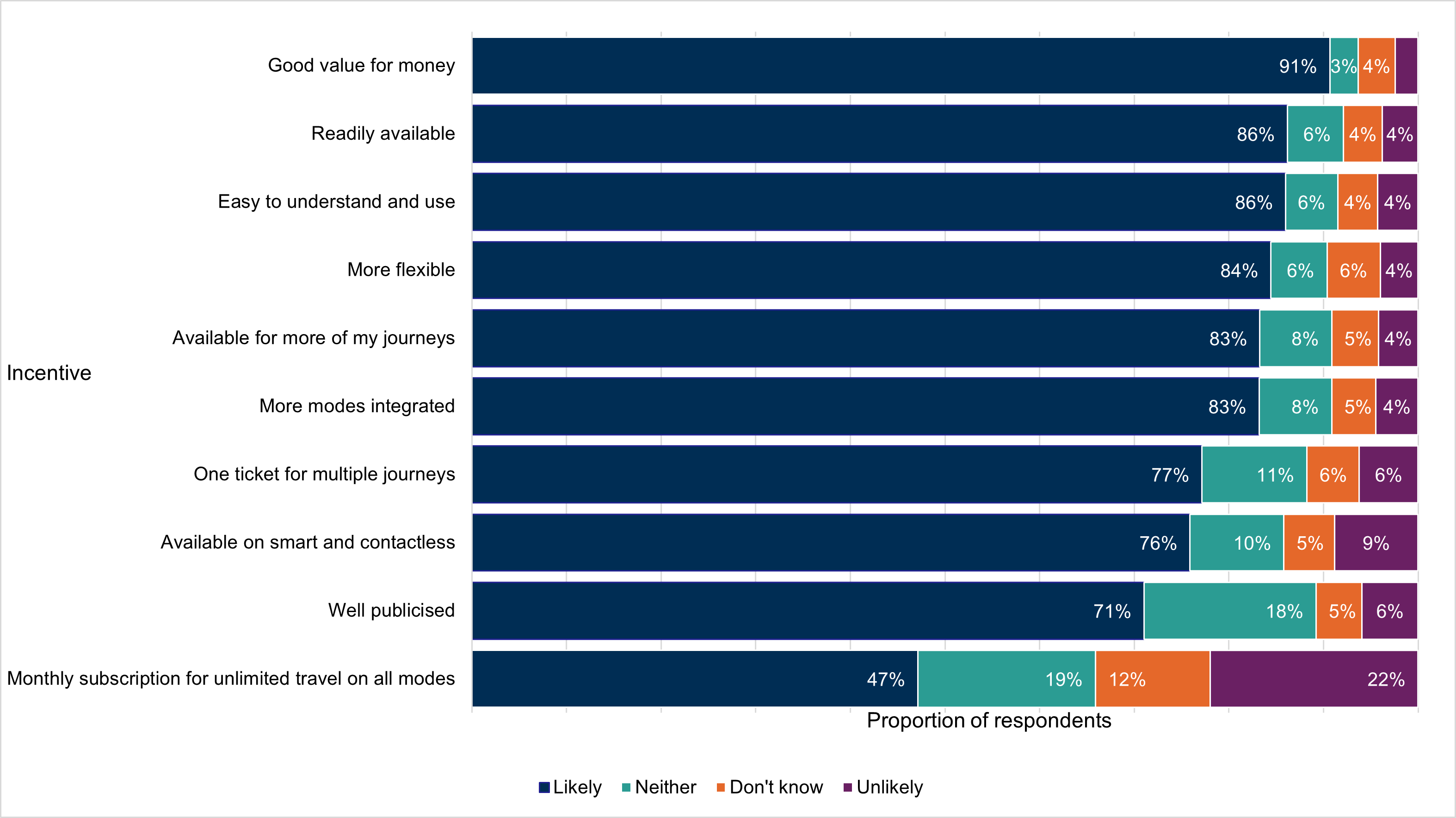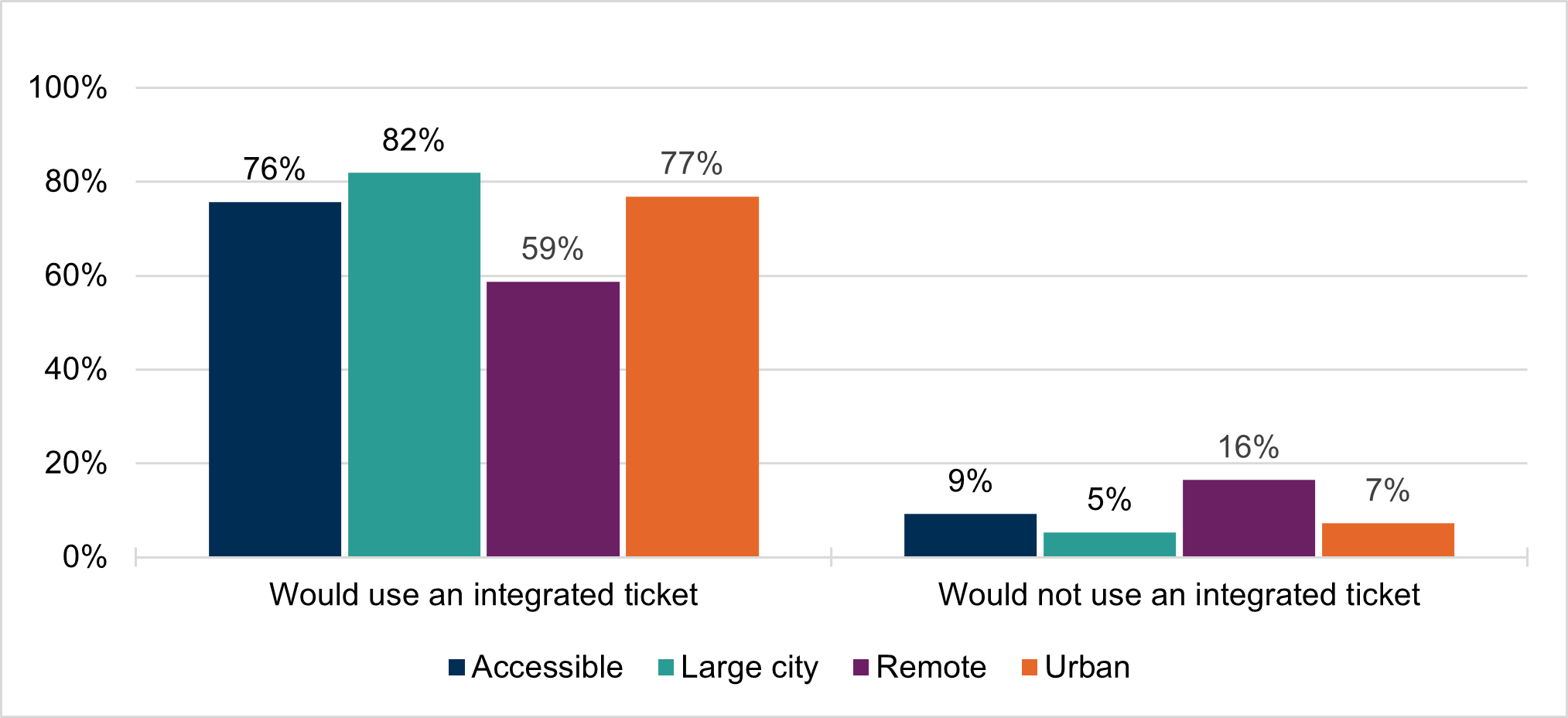Integrated ticketing - use and views
In the survey, an integrated ticket was defined as a single ticket valid for use on all parts of a journey.
79% of all respondents would like to use integrated tickets in future.
14% of people who had made a multi-modal journey had used an integrated ticket, reflecting the current availability and access to integrated ticketing. 72% of those who had used an integrated ticket had used multi-operator train tickets, making these the most popular type of integrated ticket. Table 1 provides more detail on these results.
| Integrated tickets | 5 + days a week | Few times a week | Few times a month | Less than monthly | 1-2 times a year | Less than yearly | Total responses within the survey |
|---|---|---|---|---|---|---|---|
| Multi-operator rail ticket | 0% | 4% | 16% | 30% | 41% | 10% | 81 |
| Rail & Sail | 3% | 0% | 3% | 6% | 18% | 70% | 33 |
| SPT ZoneCard | 13% | 0% | 0% | 3% | 13% | 72% | 32 |
| SPT Roundabout Ticket | 0% | 0% | 7% | 3% | 13% | 77% | 30 |
| PlusBus | 0% | 0% | 13% | 3% | 17% | 67% | 30 |
| GrassHopper (Aberdeenshire) | 0% | 0% | 3% | 7% | 3% | 86% | 29 |
| Glasgow Tripper | 0% | 0% | 3% | 7% | 7% | 83% | 29 |
| Rail Rover tickets | 0% | 0% | 3% | 3% | 10% | 83% | 29 |
| One-Ticket | 0% | 4% | 4% | 4% | 7% | 82% | 28 |
| Lothian Ridacard | 0% | 7% | 7% | 4% | 4% | 79% | 28 |
| RailBus | 0% | 0% | 4% | 7% | 4% | 86% | 28 |
| Other | 18% | 14% | 4% | 4% | 11% | 50% | 28 |
| ABC (Dundee and East Fife) | 0% | 0% | 0% | 0% | 0% | 100% | 27 |
| Don't know | 4% | 0% | 11% | 15% | 19% | 52% | 27 |
Although few respondents were currently using them, a large majority indicated that they would be likely to use an integrated ticket in future, given any of the suggested incentives (see Chart 11). 70% of respondents could be incentivised to use integrated ticketing in future for a range of features. 91% would be incentivised by the ticket providing good value for money. Less than half (47%) of respondents would be incentivised by a monthly subscription providing unlimited travel on all modes. More detail on responses to this question is provided in Annex Table 8.

The legend is presented in the same order as the categories within the bars.
The results shown in Chart 11 were fairly consistent across ages, disability status and gender. Chart 12 shows that people in urban or large city areas were more favourable towards integrated tickets than those living in remote areas, although a majority of respondents from all areas were still in favour of integrated ticketing. More research is needed to understand why this is, but may be due to availability of transport and number of different operators in rural areas.
This information is also shown in Annex Table 9. The four regional classifications – accessible, large city, remote and urban – are based on the Scottish Government Urban-Rural Classification 2020, and are broken down in Annex 3 - Disaggregated data.

Those aged 60+ were less enthusiastic about integrated tickets being available as a monthly subscription than other age groups: 26% would be incentivised by this feature, compared to 58% of people aged 16-32, and 50% of those aged 33-59. Just under a third (30%) of those aged 60+ would not find this to be an incentive, compared with 16% of people aged 16-32, and 22% of those aged 33-59. This may reflect travel patterns and transport modes available, rather than differing attitudes between age groups to the idea of a subscription itself.
Respondents were also asked if there was anything else that would encourage them to use an integrated ticket. The most common response was that respondents would like to use an integrated ticket which covered different modes, and took into account discounts already in place for the user. Respondents also mentioned the need for more flexible tickets, which covered different local authorities, times, prices and formats.
The ability to mix between bus, train and subway without it costing a fortune. If you live on the outer edges of Glasgow/Paisley then the number of zones you pass through, makes it utterly unaffordable.
Two respondents praised the ZoneCard system in the Strathclyde Partnership for Transport (SPT) region, but suggested it should be extended.
The SPT ZoneCard in Glasgow is excellent, but it needs to be available as a daily ticket, with choice of start date (other than a Sunday).”
A number of people highlighted the importance of continuing availability of paper tickets, for practical or personal reasons:
Having a system that works in broadband/mobile blackspots.”
Prefer paper tickets to be readily available (including print at home) as I do not like to rely on having a working mobile phone.”
NO. Tickets need to be available to buy with cash on site. Anything else should be an extra otherwise it is discriminatory.”
Respondents referred to systems they had used elsewhere, including London, Hong Kong, and the Netherlands, where there are multi-modal and multi-operator tickets, and fares are capped.
It’s not simply about having one ticket, across modes; the goal should be about having properly integrated ticketing, the fares of which are calculated across modes, depending on the share of the total journey…and there is no financial detriment to taking more than one mode, which there is at present. The transport system should be experienced as a whole and tickets should be automatically calculated to be the simplest and most affordable, depending on journey length.”
The ability to easily combine cycling with use of public transport was also mentioned. Some people stated that they would like bicycle hire to be included in integrated tickets.